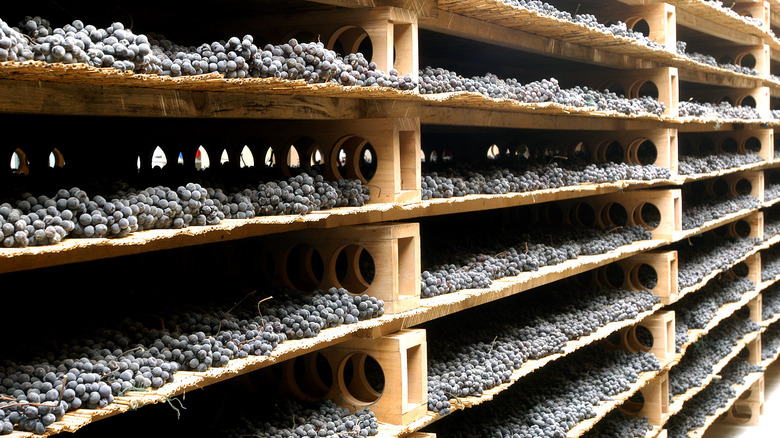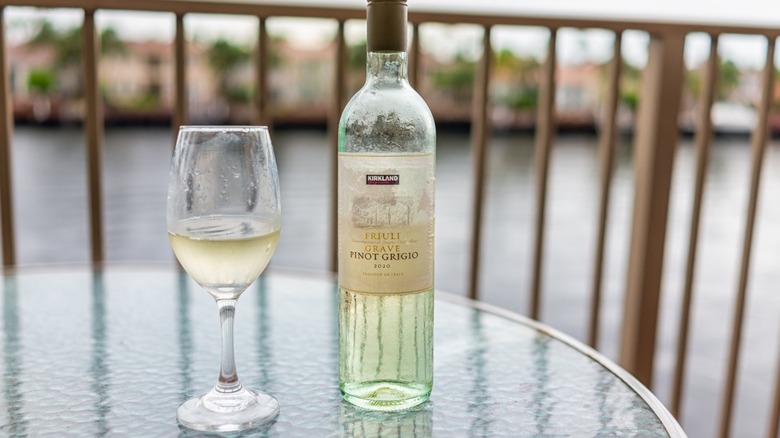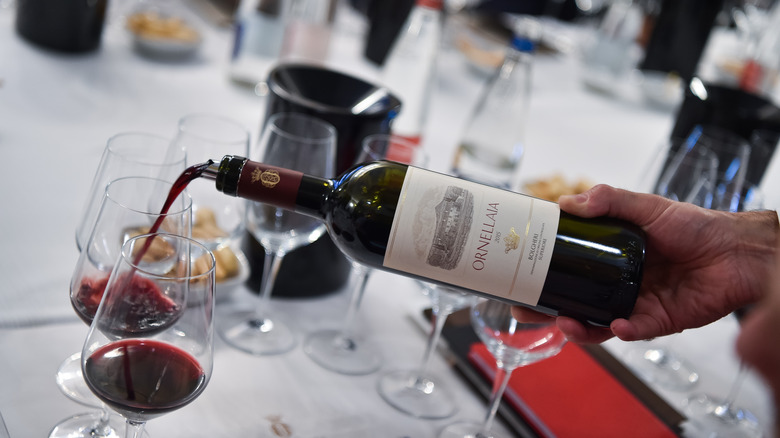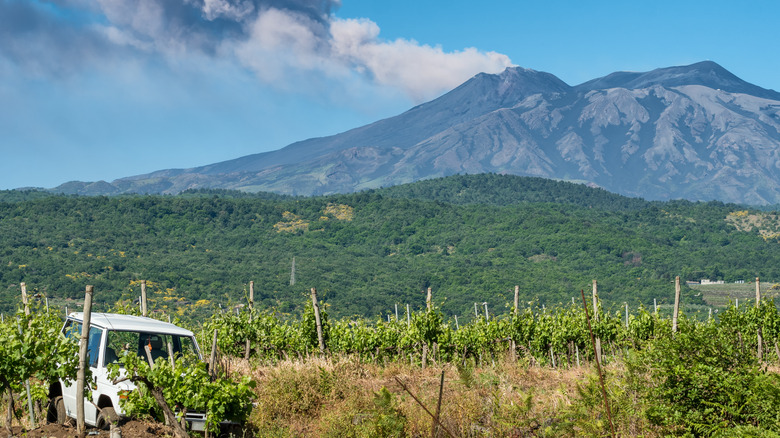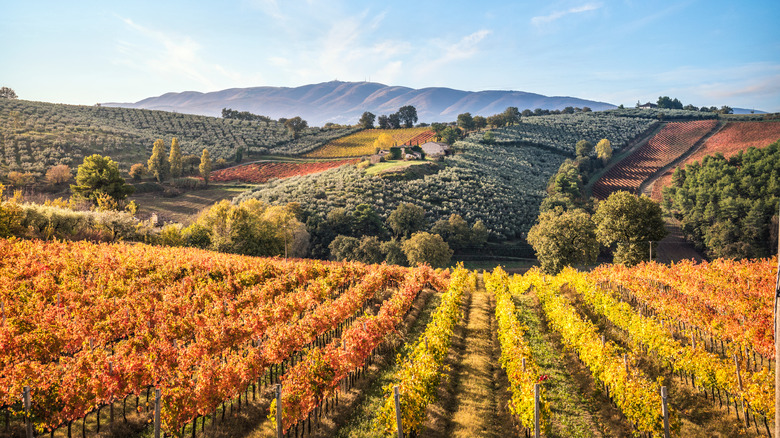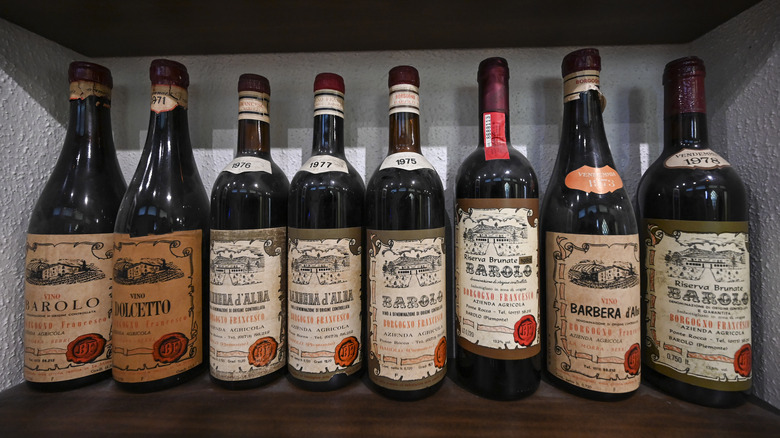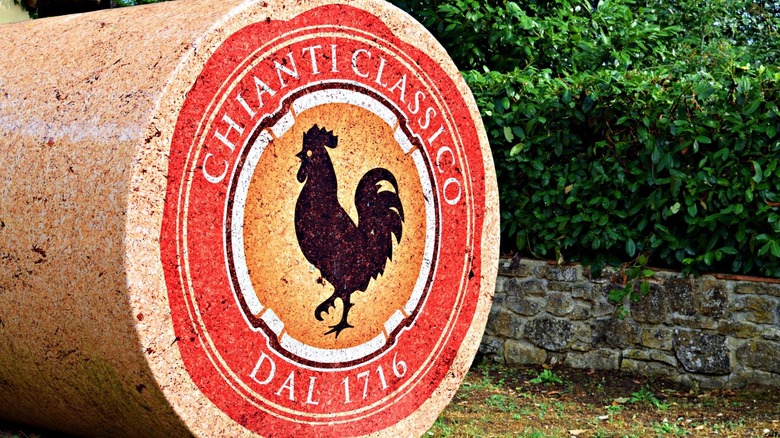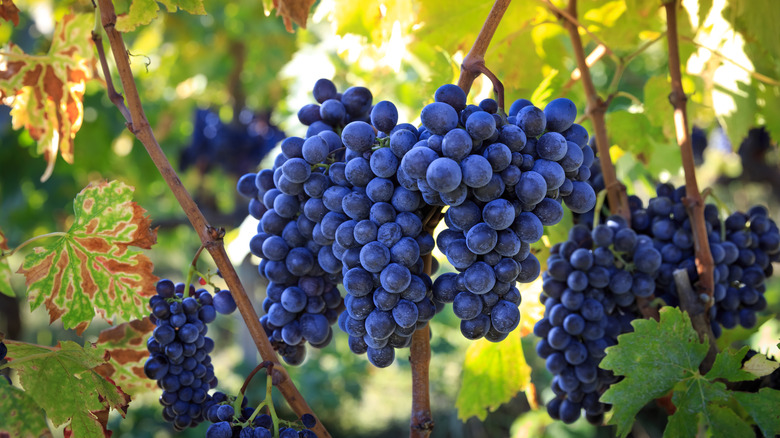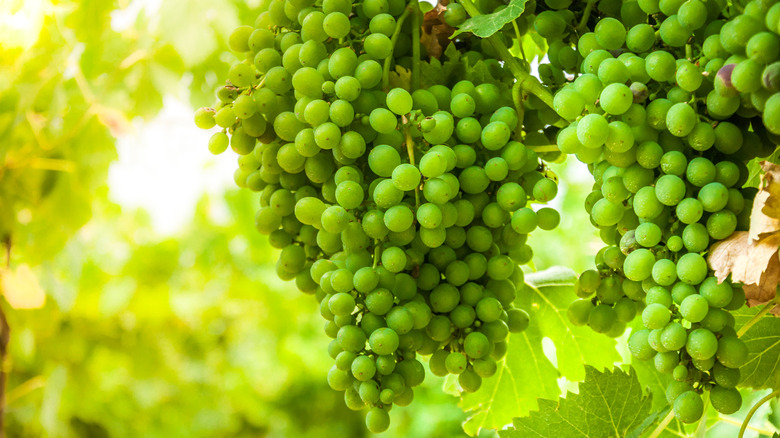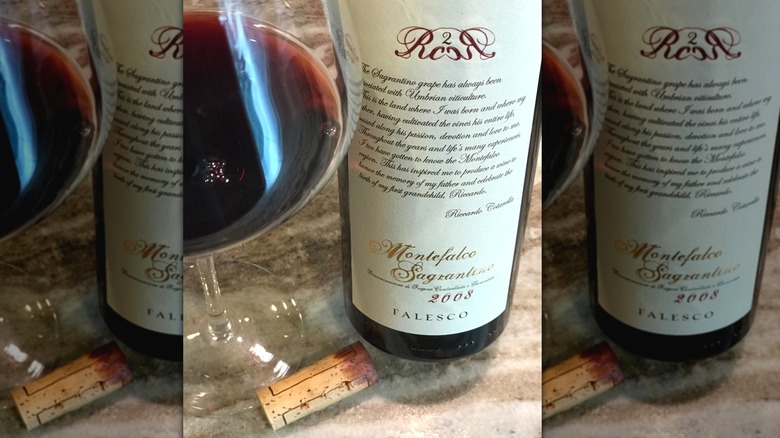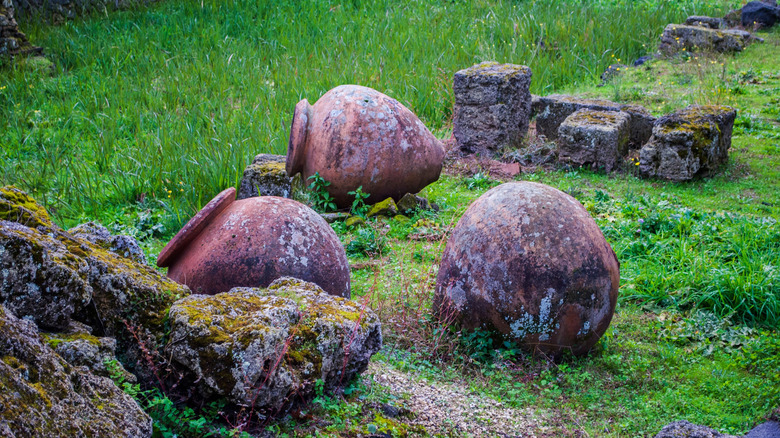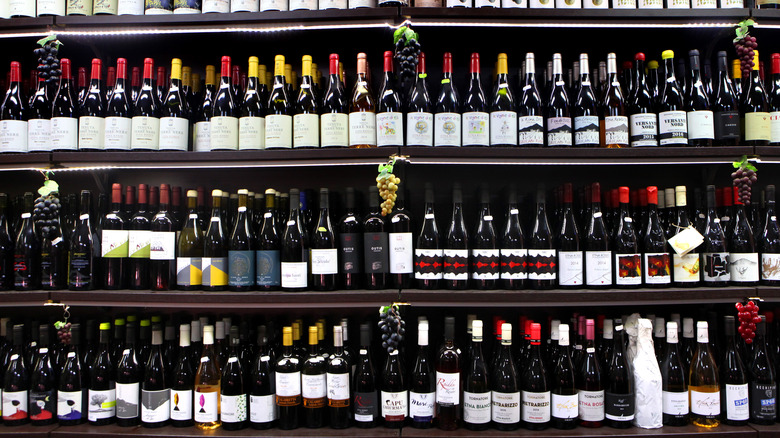A Beginner's Guide To Italian Wine
In 2022, Italy was the largest wine producer in the world, according to Statista. As well as quantity, Italy can also boast quality; some of the greatest and most sought-after wines in the world come from the country's 20 wine regions. These include the likes of Barolo, Barbaresco, and Chianti Classico.
Prestigious wines like these have developed during Italy's long winemaking history, but the country's winemakers are not resting on their laurels. Italian winemakers are at the forefront of many winemaking innovations and trends today. Novel techniques used to combat climate change, aid in the rediscovery of indigenous grape varieties, and help with the reclamation of ancient production processes are all at play in Italy's contemporary winemaking sector.
The combination of tradition, expertise, and creative flair seen in Italy's winemaking community over the centuries has resulted in the production of numerous, excellent Italian wines. Here, we'll tell you all you need to know about Italian wine.
There are many terms unique to Italian wine labels
Similarly to producers in many wine-producing countries, Italian vine makers include several terms and abbreviations on wine labels to help customers identify the type and style of the wine. Three commonly seen abbreviations are DOCG, DOC, and IGT. Each of these is a geographical indication that guarantees the wines have a specific geographical origin and the subsequent qualities to boot.
DOCG is the most tightly controlled. Wines labeled with this indication are relatively rare as it indicate guaranteed exceptional quality and tightly controlled production methods. Wines that carry the DOC indication are the next rung down; they must be produced in a specific area and have controlled production, bottling, and aging processes. IGT wines are the least controlled of the certified wines. The wine must be made in the location indicated on the label, however, foreign grapes can be used to produce them, allowing producers more space to experiment.
Some of the best wines in Northwestern Italy come from Lombardy
Northwestern Italy is jam-packed with exceptional wine regions, including Piedmont. This region is home to Barolo, one of Italy's most prestigious wines. When it comes to winemaking, Lombardy does not have the same status as its alpine neighbor. It does, however, boast a range of excellent wines.
Lombardy's most prominent wine is Franciacorta. This is an exceptional and traditional sparkling wine that demonstrates a light acidity and fresh, bright flavors. Despite this, Franciacorta has little reputation outside of Italy. The reason for this is simple: Italy keeps the vast majority of Franciacorta for itself; only 11% of all Franciacorta is exported.
In terms of red wine, Lombardy is especially well-known for using the Nebbiolo grape. The best wines made from this grape come from the Valtellina subregion in Northern Lombardy. Here, methods used to grow and harvest grapes have changed little over recent centuries resulting in reliable wines like Valtellina Superiore DOCG, a pale red wine.
Northeastern regions of Italy are known for exceptional white wines
Friuli-Venezia Giulia is a renowned Italian winemaking region that has established itself as the home of Italian white wine. In 2022, 86% of the region's produced wine was white, with pinot grigio being the area's most prominent grape.
Friuli-Venezia Giulia's pinot grigio is defined by its approachability and juicy, pear-like flavors. While all pinot grigio wines from Friuli-Venezia Giulia have similarities, they also vary widely in some ways. For example, those made from grapes grown on gentle hillsides demonstrate notes of apricot and thyme. Pinot grigios made from grapes grown on steep slopes are more intense, with higher alcoholic contents and a pronounced acidity.
Other grapes, both indigenous and foreign, are also used by the area's vintners. When it comes to indigenous varieties, the Friulano, otherwise known as Tocai, is favored by local winemakers for its ability to express terroir. Chardonnay is a popular foreign grape. In Friuli-Venezia Giulia, it is used to make wines that combine the grape's trademark creamy body with herbal flavors of sage and basil.
Tuscany, a central Italian wine region, produces some of the best wines in the world
Tuscany is a world-renowned producer of red wine. In this area, the Sangiovese grape is predominant. This versatile grape is known for its ability to express both fruity and earthy flavors, a fact that one Sangiovese wine varies greatly from the next.
In Tuscany, the earthy side of Sangiovese is most famously expressed by Chianti Classico and, in some circumstances, Brunello di Montalcino. This latter wine is also renowned for its ability to age especially well, making Brunello di Montalcino a wine favored by enthusiasts the world over.
While traditionalists still balk at it, a subgroup of wines known as super Tuscans are a large part of the area's wine-making appeal. Super Tuscans are wines made with a blend of grapes, some of them not indigenous to Tuscany. These wines often use classic French grape varieties like merlot and are frequently aged in new oak casks. The most famous example of a super Tuscan is Sassicaia, which critics have called one of the best wines in the world.
Many archetypical Southern Italian wines come from Puglia
Red wines from Italy's Southern regions tend to be fruitier than those from Northern Italy, thanks to the warmer climate. As one of Italy's southernmost regions, Puglia is one of the country's most prolific areas when it comes to producing fruit-forward red wine, something that has seen the area become a favorite of wine experts and novices alike.
Two popular grape varieties used in Puglia's red wine industry are Primitivo and Negroamaro. Of the two, Primitivo tends to form a wine that has a greater body while both hold an abundance of dark fruit flavors such as plums, figs, and berries. These bold flavors mean that Puglian reds complement a range of foods from fresh vegetables to hearty pasta dishes.
Appealingly, these highly drinkable wines are also reasonably priced. Many exceptional bottles can be purchased for under $20. These wines remain cheap because of the high production volume. In 2022, Puglia made over 10 million hectolitres of wine. Only Veneto produced more wine during that period.
Sicily is an important wine region
As with Puglia, Sicily's wine industry has long been defined by bulk production. Wines produced there were often used in blends, to strengthen other wines. As a result, Sicilian wine did not get the respect it deserved. Fortunately, this is changing.
Sicilian winemaking is defined by fruity reds that demonstrate a freshness not found in other southern wines. This is because Sicily's mountainous terrain allows for grape varieties to be grown at altitude. Nerello Mascalese, which grows on the slopes of Mount Etna, is a prime example of this. Incredibly fruity, wines made from Nerello Mascalese often demonstrate flavors of spice, as well as great acidity, along with the trademark freshness.
It's not just about altitude; Nerello Mascalese produced from vines high on Mount Etna are wholly unique, thanks to the soil they grow in. This was explained to Jascots Wine Merchants by Sicilian-based winemaker Anne-Louise Mikkelsen: "When lava soil is combined with old Nerello Mascalese vines magic happens. The terroir is so expressive and it's a challenge you can't resist ... it has great drainage which is fundamental for making good wines. The chemical composition of the numerous volcanic eruptions is absorbed in the old vines and you get this expressive mineral terroir as a result."
Umbria is a wine region on the up
Umbria, a central Italian region that borders Tuscany, has a long history of winemaking. Over this time, the region has built its reputation on Orvieto, a white wine with a flowery aroma and clean flavors. To be classified as Orvieto DOC, 40% of the wine must come from the Grechetto grape, which boasts flavors of crisp fruit.
When it comes to red wine, Umbria has one wine that stands head and shoulders above the rest: Montefalco Sagrantino. This wine is well-suited to aging, as it is made from Sagrantino, a grape that contains an impressive amount of polyphenols.
While two classic wines constitute the majority of Umbria's reputation, new wines made by innovative winemakers are becoming increasingly common. Many of these winemakers continue to use Sagrantino, often aging the wine in a variety of wooden barrels, steel vats, and cement tanks, to control the tannins.
Barolo is one of Italy's most famous wines
While Italy is a country known for producing many excellent wines, few are as respected or adored as Barolo. Barolo is produced in the Northern Italian region of Piedmont and must be made from the Nebbiolo grape. This grape is renowned for demonstrating incredibly strong tannins, one of the key reasons why Barolo ages so well.
All Barolos are made within an appellation that is seven miles long and five miles wide. Even in this small area, great differences abound. Due to soil composition, wine produced in the west of this area is lighter and better suited to drinking young. In contrast, Barolo produced in the east of the area often needs to age longer to reach its full potential.
While all Barolos are different, the wine does have some defining characteristics. These include a light color, bright acidity, and strong structure. The wine is also renowned for its bouquet. When decanted, numerous scents can be detected including red fruits and citrus. After aging, the smell of leather and spice becomes more apparent.
What makes Barolo so beguiling — and frustrating – is that many bottles require decades of aging to reach perfection. When allowed to age properly, the wine is one of the best in the world: structured, complex, but accessible. Open too early, however, and you will have an overly tannic, tight bottle of wine that is not worth the often hefty price tag.
A great example of a Classico wine is Chianti Classico
Many Italian wines boast the term "Classico" on their label. This confirms that the wine is made in the most historic region of that particular appellation. While this does not necessarily mean the wine will be superior to others produced outside of this region, the term still carries some importance, as demonstrated by Chianti Classico.
Chianti does not have the best reputation outside of Italy. Many people dismiss it as a cheap wine that comes encased in tacky straw baskets. These views are both false and reductive. Chianti Classico proves this, through its well-balanced nature. Acidity, tannins, fruit, and minerals are all prevalent. Incidentally, Chianti Classico is also one of the few reds well-suited to summer drinking.
Tighter standards mean that Classico wines are often a truer expression of the style than their non-Classico counterparts. For example, all Chianti Classico must be made from at least 80% Sangiovese. Regular Chianti, however, only contains 70% Sangiovese and can contain white grape varieties.
The country is home to over 350 grape varieties
We have alluded to Italy being the home of many wines, but we have yet to highlight the immense variety of wine-producing grapes that are grown in the country. Italy's Ministry of Agriculture and Forestry recognizes around 350 varieties of wine-producing grapes. Unlike many other wine-producing countries, many of these grapes originated in Italy. Several of these indigenous grapes are used to make Italy's most famous wines.
Sangiovese, Italy's most planted grape with over 150,000 acres of vineyard, is one such example. It is thought this grape originated in Tuscany and records of it abound from the 1500s. Over this time, it has become the foundation of many exceptional Italian wines including Chianti Classico and Brunello di Montalcino.
International varieties, such as merlot, have also proved immensely successful. This French grape is planted in 14 of Italy's 20 wine-producing regions and is routinely used to make the aforementioned super Tuscans.
Many varieties, like falanghina, are still overlooked
With so many grape varieties being present in the country, it is no surprise that some are overlooked. This has long been the case for falanghina, a grape indigenous to the Campania region of Italy. Usually used to make white wine, falanghina has routinely been dismissed, due to its reputation for producing monotonous wines.
This may not be down to the grape itself, as wine expert Levi Dalton explained to The New York Times: "I think they do have more potential, but the market rewards a lack of ambition. It's chicken and egg. Either the consumer will say, 'I want more than a simple sipper,' or the producer needs to say, 'I want to do something more serious, rather than pandering to the consumer.'"
Thankfully, we are starting to see more expressive, daring wines made from falanghina. Terre Stregate's Falanghina "Caracara" is one such example. Using late-harvested grapes, and undertaking an aging process in barriques, sees the wine take on a more flavorful nature, defined by honey and melon along with cutting acidity.
In terms of red wine, Montefalco Sagrantino is often passed over
Just as many grape varieties get passed over, so do certain Italian wines. Montefalco Sagrantino is one such wine. The reason for Montefalco Sagrantino flying somewhat under the radar is simple; it is produced in Umbria, a region that does not have the respect afforded to other winemaking regions.
Another reason why Montefalco Sagrantino has not burst into the mainstream is that it is extremely tannic. Experts have even labeled it Italy's most tannic wine.
While this ensures the wine ages well, winemakers have been attempting to control the tannins so the wine can be drunk young. Umbrian winemaker Filippo Antonelli explained how this is achieved to Forbes: "Some producers do a short skin contact, but others (like us) do the opposite: when tannins are ripe we do a very long skin contact; the result is different: less tannins in the first case, tamed tannins in the second case ... Now you don't have to wait 15-20 years to enjoy a Sagrantino."
Italy's success with Prosecco has reached astronomical heights
The rise of Prosecco has been the Italian wine industry's most prominent success in recent decades. Originally, Prosecco was the name of a grape variety. This changed in 2009 when the Italian region of Veneto successfully campaigned to rename the Prosecco grape glera and to create a Prosecco appellation in Veneto and Friuli-Venezia Giulia. From this point onwards, the only wine that could be called Prosecco had to be produced within this appellation giving Italy a monopoly on the product.
The legislature changes proved to be a lucrative move; today, Prosecco sales outstrip both Champagne and Cava combined. Of the 5.2 million hectolitres of sparkling wine Italy exported in 2022, 3.7 million hectolitres were Prosecco.
Prosecco's mass production is not without its downfalls. Residents of the DOCG area complain of ruthless expansion that comes at the cost of the natural environment. Unfortunately, expansion does not look like it will slow down anytime soon. Demand for sparkling wine has been revitalized as new iterations of the product, including rosé Prosecco, are becoming increasingly popular.
Production of rosé is declining in Italy
Italy's first rosé — known in the country as rosato — was produced in 1943. The wine, Five Roses, is produced using the Negroamaro grape and it epitomizes all that is good about this style of Italian wine with clear flavors and bright acidity.
While Five Roses is an excellent Italian rosé, it does not define the sector. Unlike rosé from other countries, those produced in Italy vary widely from region to region and are often deemed the most sophisticated rosé wines in the world. But despite being responsible for an array of excellent wines, Italy's rosé producers are struggling. Since 2000, both the production and consumption of rosé have fallen in Italy.
An organization called the Rosautoctono Italian Wine Institute is looking to change that by championing traditionally made Italian rosés that utilize indigenous grapes. As wine educator T.J. Douglas explained to Food & Wine, this movement is about pushing consumers beyond commercial rosé into serious, well-created wine: "The easiest way to think about Rosautoctono is as the anti 'Yes Way Rosé' movement. This isn't about drinking nameless, region-less rosé on Instagram for the likes. It's about digging deep into terroir and understanding why these areas of Italy are making world-class wine—that just happens to be pink." Whether this revitalizes the stammering sector, however, remains to be seen.
Wine has been made in Italy for over 6,000 years
An archaeological discovery in Sicily in 2012 upended the history of Italian wine. Until that moment, it had been postulated that wine production began in Italy around 1300 B.C. After finding ancient pottery in Sicily and testing the residue inside them, scientists proved that winemaking has actually been occurring in Italy for around 6,000 years.
Davide Tanasi, the project's lead archaeologist, said to The Guardian: "Unlike earlier discoveries that were limited to vines and so showed only that grapes were being grown, our work has resulted in the identification of a wine residue. That obviously involves not just the practice of viticulture but the production of actual wine – and during a much earlier period."
This not only changes what is known about the history of Italian winemaking but also the history of winemaking in Sicily. It was previously thought that the Phonecians brought viticulture to the island around 1000 B.C. However, this discovery suggests that Sicily's winemaking traditions began with its indigenous populations.
Italy produces more white wine than red
Although Italy's most famed wines may be reds like Barolo, the country actually produces a larger volume of white wine. In 2020, BKWine Magazine reported that 57% of all wine produced in Italy was white.
A huge proportion of this white wine — 200 million bottles annually – is pinot grigio. The grape itself originated in France, but the wine is now synonymous with northern Italy. Today, numerous regions produce their own style of this ubiquitous wine. Generally speaking, pinot grigio is an uncomplicated and approachable wine, two key facets of its enduring popularity all over the world.
Although white wine is most closely associated with Italy's northern regions, just about everywhere in Italy has a local white wine to call its own. Even in Calabria, the southernmost tip of mainland Italy, excellent white wine is produced. Here, white wines are often sweet, produced in a method known as passito, where grapes are dried before being crushed and fermented.
More women are gaining leadership roles in Italy's wine industry
Like many agricultural professions, winemaking in Italy has traditionally been male-dominated. This, however, is beginning to change. Women are becoming increasingly present in Italian viticulture both as winemakers and estate owners. Le Donne del Vino, an organization for Italian women who work in wine, now has over 1,000 members.
Few have burst onto the scene as rapidly as Arianna Occhipinti, a Sicilian winemaker who resolutely sticks by organic practices and Sicilian grape varieties. Because of this approach, Occhipinti's wines are marked by their freshness and are deemed to be among the best wines coming out of Sicily.
While Occhipinti built her own winery, other women come from families long involved in the industry. The three Antinori sisters, Albiera, Allegra, and Alessia, inherited the prestigious wine company Marchesi Antinori from their father. They are the first female owners of the company in over 600 years. Since the sisters took over, the company has gone from strength to strength. Most recently the company announced its takeover of Stag's Leap, an American winery based in Napa Valley.
Italy is known for several innovative production methods
The Italian wine industry boasts many innovative production methods. A classic example of this is appassimento, a process of partially drying grapes once they have been harvested. While this method has been linked with ancient Greece, it's used to make some of Italy's most famous wines including Amarone.
Some producers have turned to the sea when aging their bottled wine. Marco Bacci is one such producer. He stores his wine under the sea for six to twelve months. During this time, the wine ages exceptionally well thanks to constant pressure, temperature, and the gentle motion of the waves which causes the wine to circulate.
Innovative production methods are also being used to combat the challenges faced by contemporary winemakers, most notably climate change. One Tuscan wine estate Col d'Orcia is using zeolite, a chemical compound championed by NASA, to hoard water in the soil. This moisture is released during drought, helping to mitigate the effects of water scarcity.
Ancient production techniques are also being revitalized
Historical methods are being reintroduced by contemporary winemakers in an effort to garner interest and recreate the wines of the past. For example, winemaker Antonio Arrighi has started submerging his grapes in the sea for five days, an ancient process that creates something known as marine wine. This style of wine was purportedly served to Julius Caesar and surprisingly, resulted in a well-rounded wine. Thanks to its elevated salt content this wine does not require the addition of preservatives. In other words, it can be deemed a natural wine.
Aside from including more salt, submerging the ansonica grapes in water for five days removes surface bloom and accelerates the drying process that occurs once the grapes have been taken from the ocean. The end result is a golden wine called Nesos which has been described as delicate and refreshing. Only small batches of the wine have ever been produced, marking this more of an experiment than an industry-changing innovation.
Great Italian wine does not have to be expensive
Despite all its prestige and history, fantastic bottles of Italian wine are not always expensive. In fact, the country is known for producing excellent, affordable wines; even great examples of Italy's most prestigious wine, Barolo, can be found for around $60.
When it comes to the less prestigious styles, fantastic Italian wine is incredibly affordable. Many wines that have been scored 90 or more out of 100 by wine experts can be purchased for $15. Such a price is not rare and should result in an excellent bottle being purchased.
Italian wine remains affordable because of how much is produced. With so much competition, producers must price their wine competitively. What's more, nearly half of all Italian wine is produced without any geographical indications. These wines must be priced cheaply to compete with their DOCG, DOC, and IGT counterparts.


